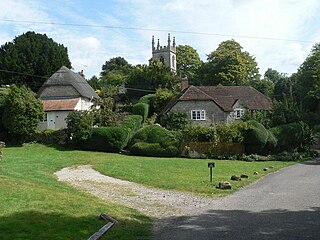
Wiltshire is a ceremonial county in South West England. It borders Gloucestershire to the north, Oxfordshire to the north-east, Berkshire to the east, Hampshire to the south-east, Dorset to the south, and Somerset to the west. The largest settlement is Swindon, and Trowbridge is the county town.

Wiltshire is a historic county located in the South West England region. Wiltshire is landlocked and is in the east of the region.

Bishopstone is a village and civil parish in Wiltshire, England, in the Ebble valley about 5.5 miles (9 km) south-west of Salisbury. The parish is on the county boundary with Hampshire and includes the small village of Croucheston and the hamlet of The Pitts.

Boyton is a village and civil parish in Wiltshire, England. It lies in the Wylye Valley within Salisbury Plain, about 6 miles (10 km) south-east of Warminster and 13 miles (21 km) north-west of Salisbury. The parish includes the village of Corton.
John Barnard Bush was an English farmer, landowner, and Justice of the Peace. He was High Sheriff of Wiltshire for 1997, a Deputy Lieutenant of Wiltshire from 1998, and from 2004 to 2012 was Lord Lieutenant of Wiltshire.

The Goddard family were a prominent landed family chiefly living in the northern regions of the English counties of Wiltshire and Hampshire and the western part of Berkshire, between the Tudor period and the early 20th century.

Horningsham is a small village and civil parish in Wiltshire, England, on the county border with Somerset. The village lies about 4 miles (6 km) southwest of the town of Warminster and 4+1⁄2 miles (7 km) southeast of Frome, Somerset.

This is a list of the sheriffs and high sheriffs of Wiltshire.

Ashton Gifford House is a Grade II listed country house in the hamlet of Ashton Gifford, part of the civil parish of Codford in the English county of Wiltshire. Ashton Gifford House is mentioned in the Wiltshire edition of the Pevsner Architectural Guides. The house was built during the early 19th century, following the precepts of Georgian architecture, and its estate eventually included all of the hamlet or tithing of Ashton Gifford. The house sits in the Wylye valley, part of the Cranborne Chase Area of Outstanding Natural Beauty.

Norton Bavant is a small village and civil parish in Wiltshire, England, 2 miles (3.2 km) southeast of Warminster.
Lieutenant-General Sir Maurice Robert Johnston, was a British Army officer. He served as Deputy Chief of the Defence Staff from 1981 to 1982, and Lord Lieutenant of Wiltshire from 1996 to 2004.
The Wiltshire Historic Buildings Trust is a charitable organisation which works to preserve the architectural heritage of Wiltshire, in the West of England.

Sir Edward Hungerford (1596–1648) of Corsham, Wiltshire and of Farleigh Castle in Wiltshire, Member of Parliament, was a landowner and a Parliamentarian commander during the English Civil War. He occupied and plundered Salisbury in 1643, and took Wardour and Farleigh castles.

Heywood is a civil parish and small village in the county of Wiltshire in southwestern England. The village is approximately 1.5 miles (2.4 km) north of Westbury and 3.5 miles (5.6 km) south of the county town of Trowbridge.

Fisherton de la Mere, also spelt Fisherton Delamere, is a small village and former civil parish, now in the parish of Wylye, on the River Wylye, Wiltshire, England. The village lies just off the A36, midway between Salisbury and Warminster, each about 10 miles (16 km) distant. The parish came to an end in 1934 and was divided between Wylye and Stockton, the latter gaining the hamlet of Bapton while the village of Fisherton de la Mere retained a separate identity within Wylye. In 1931 the parish had a population of 195.

Teffont Evias is a small village and former civil parish, now in the parish of Teffont, on the Nadder valley in the south of Wiltshire, England. Edric Holmes described the village as "most delightfully situated", and Maurice Hewlett included Teffont in his list of the half dozen most beautiful villages in England. The present buildings are mostly of local stone, and several are thatched.

Pertwood is an ancient settlement and former civil parish, near Warminster in the county of Wiltshire in the west of England. Its land and houses now lie in the parishes of Brixton Deverill, East Knoyle, Sutton Veny and Chicklade, and have fewer than twenty inhabitants.

Wilcot is a village and former civil parish, now in the parish of Wilcot, Huish and Oare, in Wiltshire, England, in the Vale of Pewsey about 6 miles (10 km) southwest of Marlborough and 1.5 mi (2.4 km) northwest of Pewsey. In 2011 the parish had a population of 558.

Wardour Castle in Wiltshire, England, was besieged twice during the First English Civil War; once in May 1643, and then again between November 1643 and March 1644.

The first-ever Elections to Wiltshire County Council were held on 23 January 1889. Sixty members were up for election, with up to twenty more voting aldermen to be appointed by the new council.





















